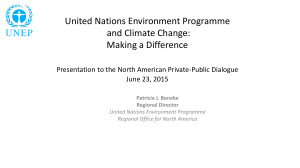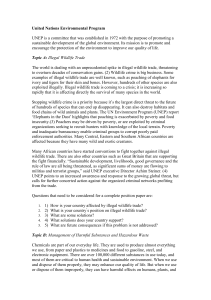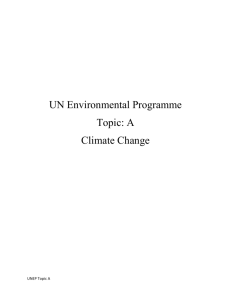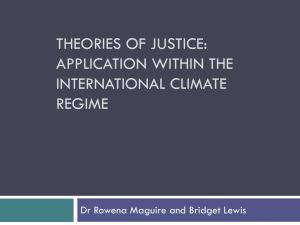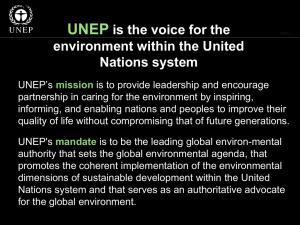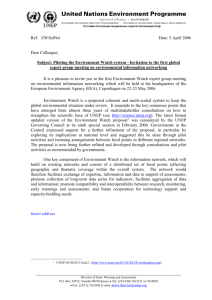Topic A: Development of an International Framework Addressing
advertisement
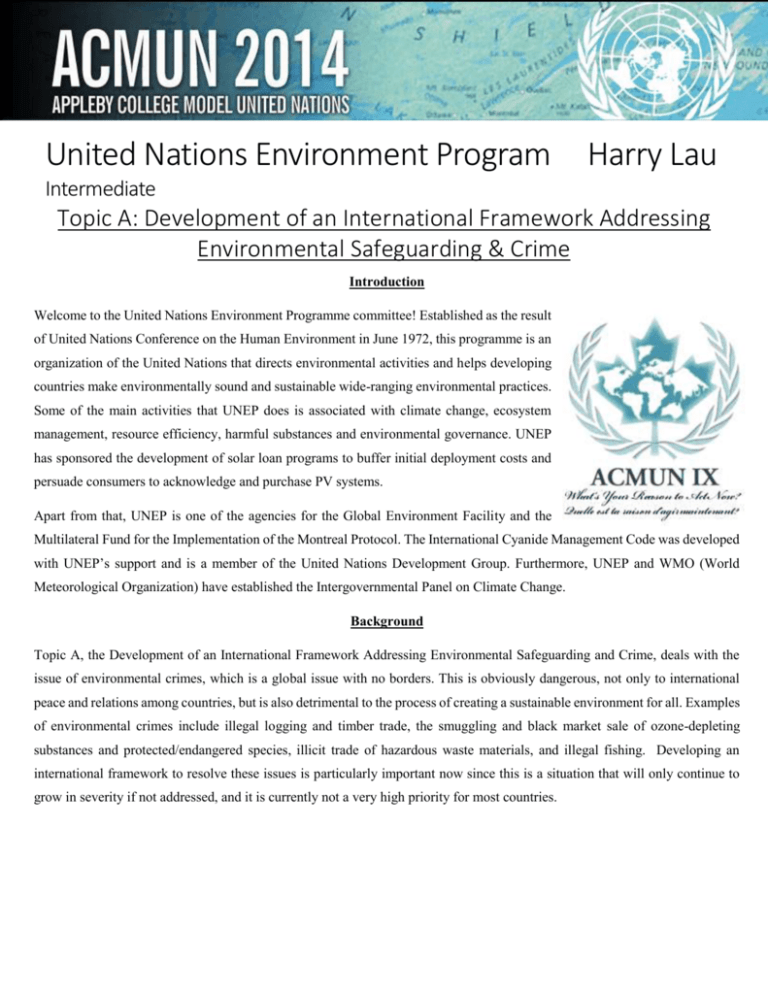
United Nations Environment Program Harry Lau Intermediate Topic A: Development of an International Framework Addressing Environmental Safeguarding & Crime Introduction Welcome to the United Nations Environment Programme committee! Established as the result of United Nations Conference on the Human Environment in June 1972, this programme is an organization of the United Nations that directs environmental activities and helps developing countries make environmentally sound and sustainable wide-ranging environmental practices. Some of the main activities that UNEP does is associated with climate change, ecosystem management, resource efficiency, harmful substances and environmental governance. UNEP has sponsored the development of solar loan programs to buffer initial deployment costs and persuade consumers to acknowledge and purchase PV systems. Apart from that, UNEP is one of the agencies for the Global Environment Facility and the Multilateral Fund for the Implementation of the Montreal Protocol. The International Cyanide Management Code was developed with UNEP’s support and is a member of the United Nations Development Group. Furthermore, UNEP and WMO (World Meteorological Organization) have established the Intergovernmental Panel on Climate Change. Background Topic A, the Development of an International Framework Addressing Environmental Safeguarding and Crime, deals with the issue of environmental crimes, which is a global issue with no borders. This is obviously dangerous, not only to international peace and relations among countries, but is also detrimental to the process of creating a sustainable environment for all. Examples of environmental crimes include illegal logging and timber trade, the smuggling and black market sale of ozone-depleting substances and protected/endangered species, illicit trade of hazardous waste materials, and illegal fishing. Developing an international framework to resolve these issues is particularly important now since this is a situation that will only continue to grow in severity if not addressed, and it is currently not a very high priority for most countries. Issues 1. Why is this an important issue? One of the most important reasons as to the relevance of this issue is the vital safeguarding of Earth’s a) environmental health. Presently, the development of environmental law faces many obstacles which impede progress, including: b) Substantial time lag between scientific research and understanding, and the actual creation of a law which takes those findings into account, particularly at different levels (regional, national, international – which this committee deals with). c) Outdated or ineffective international agreements and protocols which do not address environmental issues and sensitive situations as smoothly as possible, these need to be updated in order to rectify growing problems which will only grow in severity. d) The lack of comprehensive environmental laws which safeguard natural resources and delicate ecosystems, and insufficient capacity to fully implement these laws, particularly in developing countries. e) Illegal black market trading of resources and endangered animal materials, which if left unchecked will continue to lead species to extinction and encourage more traders. f) The illicit disposal and dumping of toxic waste and harmful substances produced as by-products in development and industrialization is also quite an essential issue, if left unchecked and unregulated such practices could lead to increased levels of air pollutants, radiation, and un-inhabitable land. 2. a) Important historical events which relate to the topic In 1992, the UNFCCC, or United Nations Framework Convention on Climate Change was established as a treaty for countries to discuss and consider solutions to limiting climate change, global warming, temperature increases, and the resultant consequences. b) In 1995, building upon the basis set by the UNFCCC, member nations believed that previously set agreements were inadequate and so came up with the Kyoto Protocol, which legally binds developed countries to a specific emission amount which they must not go over, lest they incur penalties. This was part of the implementation of a goal by many countries to reduce their emissions of damaging substances, and currently extends until 2020, after which further discussion will take place. Past UN Actions As stated in the above section, past UN actions with regards to this issue include the development of the UNFCCC, and the Kyoto Protocol derived from that. Other actions include the consideration of Nuclear Energy projects by the UNFCCC in 2008, and other UN-supported developments such as the CDM (Clean Development Mechanism), Cancun Agreement, and Conference of Parties under the UNFCCC. Delegates, please research these for further information – they could potentially be very helpful! Keys of the Resolution 1. Economic Guidelines – Rules establishing natural resources and trading to ensure sustainability, possible amendments to existing laws or claims that could be made to improve the situation 2. Regulations – Concrete rules and guidelines regarding the disposal of harmful waste, and correct handling of these substances 3. Treaties between States – Agreements held between two or more nations stating environmental emissions and trading claims/restrictions that are to be honored – extensions to existing protocols? 4. Suggestions for the Future – Advisory opinions stating what should be done in the event of further geographical, political, and climate shifts based on environmental factors 5. Logistics – General logistics and estimated plans needed to put proposed resolutions into place
